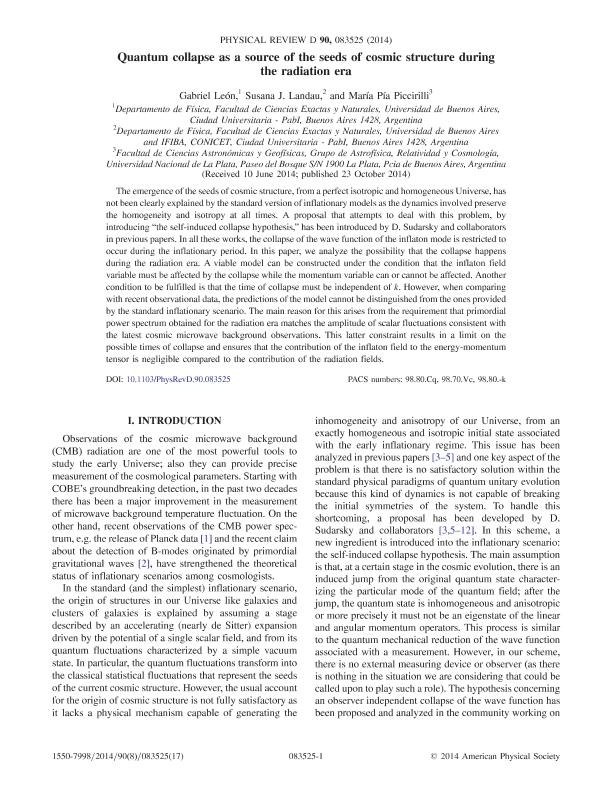Mostrar el registro sencillo del ítem
dc.contributor.author
Leon, Gabriel
dc.contributor.author
Landau, Susana Judith

dc.contributor.author
Piccirilli, María Pía

dc.date.available
2018-08-07T15:36:06Z
dc.date.issued
2014-10
dc.identifier.citation
Leon, Gabriel; Landau, Susana Judith; Piccirilli, María Pía; Quantum collapse as a source of the seeds of cosmic structure during the radiation era; American Physical Society; Physical Review D; 90; 8; 10-2014; 83525,1-17
dc.identifier.issn
0556-2821
dc.identifier.uri
http://hdl.handle.net/11336/54424
dc.description.abstract
The emergence of the seeds of cosmic structure, from a perfect isotropic and homogeneous Universe, has not been clearly explained by the standard version of inflationary models as the dynamics involved preserve the homogeneity and isotropy at all times. A proposal that attempts to deal with this problem, by introducing "the self-induced collapse hypothesis," has been introduced by D. Sudarsky and collaborators in previous papers. In all these works, the collapse of the wave function of the inflaton mode is restricted to occur during the inflationary period. In this paper, we analyze the possibility that the collapse happens during the radiation era. A viable model can be constructed under the condition that the inflaton field variable must be affected by the collapse while the momentum variable can or cannot be affected. Another condition to be fulfilled is that the time of collapse must be independent of k . However, when comparing with recent observational data, the predictions of the model cannot be distinguished from the ones provided by the standard inflationary scenario. The main reason for this arises from the requirement that primordial power spectrum obtained for the radiation era matches the amplitude of scalar fluctuations consistent with the latest cosmic microwave background observations. This latter constraint results in a limit on the possible times of collapse and ensures that the contribution of the inflaton field to the energy-momentum tensor is negligible compared to the contribution of the radiation fields.
dc.format
application/pdf
dc.language.iso
eng
dc.publisher
American Physical Society

dc.rights
info:eu-repo/semantics/openAccess
dc.rights.uri
https://creativecommons.org/licenses/by-nc-sa/2.5/ar/
dc.subject
Cosmology
dc.subject
Quantum Collapse
dc.subject
Radiation
dc.subject.classification
Astronomía

dc.subject.classification
Ciencias Físicas

dc.subject.classification
CIENCIAS NATURALES Y EXACTAS

dc.title
Quantum collapse as a source of the seeds of cosmic structure during the radiation era
dc.type
info:eu-repo/semantics/article
dc.type
info:ar-repo/semantics/artículo
dc.type
info:eu-repo/semantics/publishedVersion
dc.date.updated
2018-07-30T13:50:51Z
dc.journal.volume
90
dc.journal.number
8
dc.journal.pagination
83525,1-17
dc.journal.pais
Estados Unidos

dc.journal.ciudad
Nueva York
dc.description.fil
Fil: Leon, Gabriel. Universidad de Buenos Aires. Facultad de Ciencias Exactas y Naturales. Departamento de Física; Argentina
dc.description.fil
Fil: Landau, Susana Judith. Universidad de Buenos Aires. Facultad de Ciencias Exactas y Naturales. Departamento de Física; Argentina. Consejo Nacional de Investigaciones Científicas y Técnicas. Oficina de Coordinación Administrativa Ciudad Universitaria. Instituto de Física de Buenos Aires. Universidad de Buenos Aires. Facultad de Ciencias Exactas y Naturales. Instituto de Física de Buenos Aires; Argentina
dc.description.fil
Fil: Piccirilli, María Pía. Universidad Nacional de La Plata. Facultad de Ciencias Astronómicas y Geofísicas; Argentina
dc.journal.title
Physical Review D

dc.relation.alternativeid
info:eu-repo/semantics/altIdentifier/url/http://journals.aps.org/prd/abstract/10.1103/PhysRevD.90.083525
dc.relation.alternativeid
info:eu-repo/semantics/altIdentifier/doi/http://dx.doi.org/10.1103/PhysRevD.90.083525
Archivos asociados
